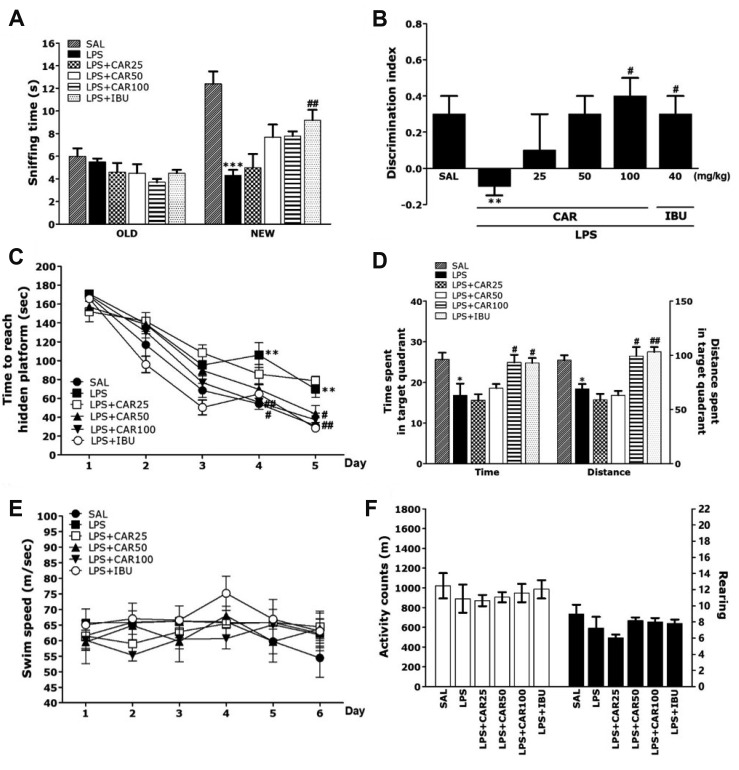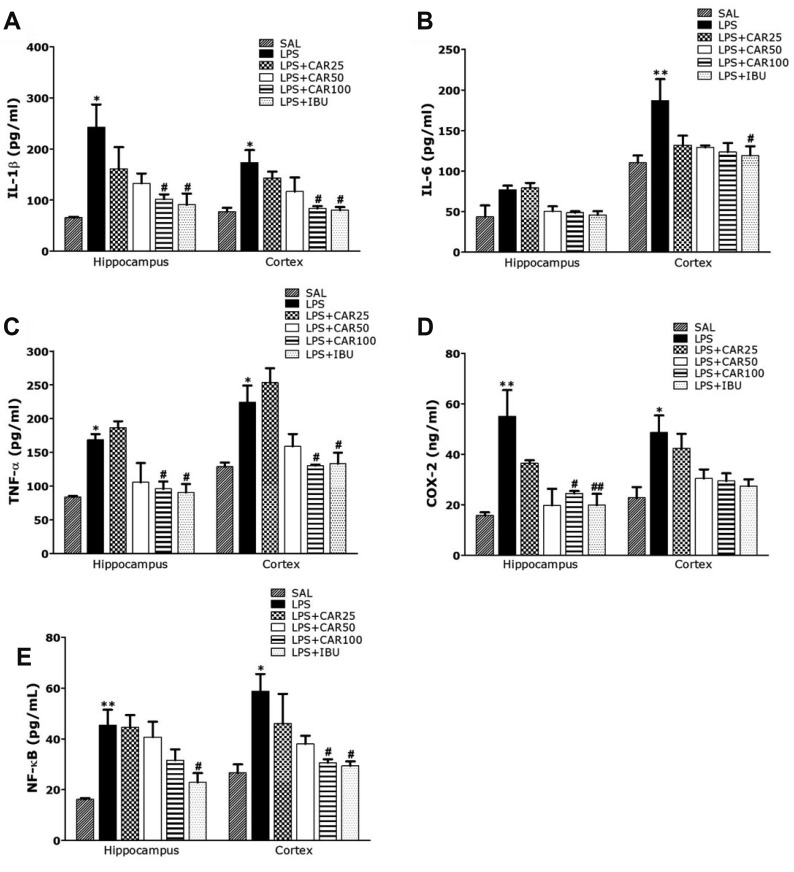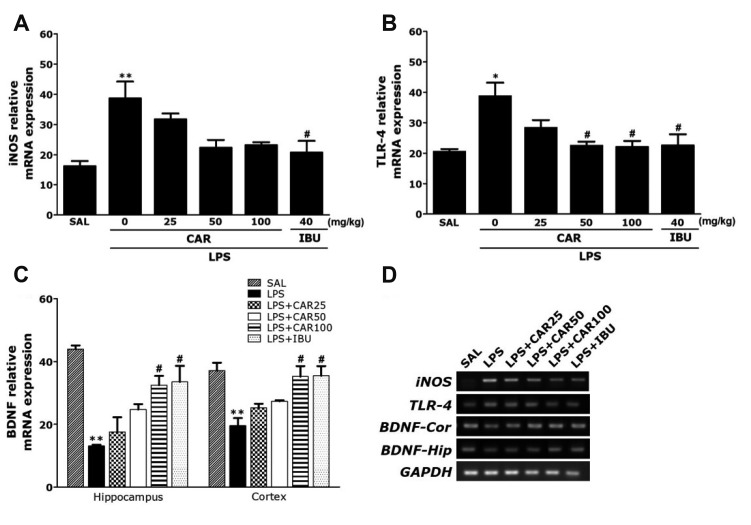Korean J Physiol Pharmacol.
2020 Jan;24(1):27-37. 10.4196/kjpp.2020.24.1.27.
Inhibitory effect of carvacrol on lipopolysaccharide-induced memory impairment in rats
- Affiliations
-
- 1Acupuncture and Meridian Science Research Center, College of Korean Medicine, Kyung Hee University, Seoul 02447, Korea. bombi@khu.ac.kr
- 2Center for Converging Humanities, Kyung Hee University, Seoul 02447, Korea.
- 3Department of Physiology, College of Medicine, Kyung Hee University, Seoul 02447, Korea.
- KMID: 2466567
- DOI: http://doi.org/10.4196/kjpp.2020.24.1.27
Abstract
- Neuroinflammation is an important process underlying a wide variety of neurodegenerative diseases. Carvacrol (CAR) is a phenolic monoterpene commonly used as a food additive due to its antibacterial properties, but it has also been shown to exhibit strong antioxidative, anti-inflammatory, and neuroprotective effects. Here, we sought to investigate the effects of CAR on inflammation in the hippocampus and prefrontal cortex, as well as the molecular mechanisms underlying these effects. In our study, lipopolysaccharide was injected into the lateral ventricle of rats to induce memory impairment and neuroinflammation. Daily administration of CAR (25, 50, and 100 mg/kg) for 21 days improved recognition, discrimination, and memory impairments relative to untreated controls. CAR administration significantly attenuated expression of several inflammatory factors in the brain, including interleukin-1β, tumor necrosis factor-α, and cyclooxygenase-2. In addition, CAR significantly increased expression of brain-derived neurotrophic factor (BDNF) mRNA, and decreased expression of Toll-like receptor 4 (TLR4) mRNA. Taken together, these results show that CAR can improve memory impairment caused by neuroinflammation. This cognitive enhancement is due to the anti-inflammatory effects of CAR medicated by its regulation of BDNF and TLR4. Thus, CAR has significant potential as an inhibitor of memory degeneration in neurodegenerative diseases.
MeSH Terms
-
Animals
Brain
Brain-Derived Neurotrophic Factor
Cyclooxygenase 2
Cytokines
Discrimination (Psychology)
Food Additives
Hippocampus
Inflammation
Lateral Ventricles
Lipopolysaccharides
Memory*
Necrosis
Neurodegenerative Diseases
Neuroprotective Agents
Phenol
Prefrontal Cortex
Rats*
RNA, Messenger
Toll-Like Receptor 4
Brain-Derived Neurotrophic Factor
Cyclooxygenase 2
Cytokines
Food Additives
Lipopolysaccharides
Neuroprotective Agents
Phenol
RNA, Messenger
Toll-Like Receptor 4
Figure
Reference
-
1. Zipp F, Aktas O. The brain as a target of inflammation: common pathways link inflammatory and neurodegenerative diseases. Trends Neurosci. 2006; 29:518–527. PMID: 16879881.
Article2. Kovaiou RD, Herndler-Brandstetter D, Grubeck-Loebenstein B. Age-related changes in immunity: implications for vaccination in the elderly. Expert Rev Mol Med. 2007; 9:1–17.
Article3. Liu WM, van der Zeijst BA, Boog CJ, Soethout EC. Aging and impaired immunity to influenza viruses: implications for vaccine development. Hum Vaccin. 2011; 7 Suppl:94–98. PMID: 21301210.
Article4. Widmann CN, Heneka MT. Long-term cerebral consequences of sepsis. Lancet Neurol. 2014; 13:630–636. PMID: 24849863.
Article5. Cunningham C, Hennessy E. Co-morbidity and systemic inflammation as drivers of cognitive decline: new experimental models adopting a broader paradigm in dementia research. Alzheimers Res Ther. 2015; 7:33–40. PMID: 25802557.
Article6. Mrak RE. Neuropathology and the neuroinflammation idea. J Alzheimers Dis. 2009; 18:473–481. PMID: 19584454.
Article7. Schwab C, McGeer PL. Inflammatory aspects of Alzheimer disease and other neurodegenerative disorders. J Alzheimers Dis. 2008; 13:359–369. PMID: 18487845.
Article8. Jin Y, Peng J, Wang X, Zhang D, Wang T. Ameliorative effect of ginsenoside Rg1 on lipopolysaccharide-induced cognitive impairment: role of cholinergic system. Neurochem Res. 2017; 42:1299–1307. PMID: 28078612.
Article9. Dehkordi NG, Noorbakhshnia M, Ghaedi K, Esmaeili A, Dabaghi M. Omega-3 fatty acids prevent LPS-induced passive avoidance learning and memory and CaMKII-α gene expression impairments in hippocampus of rat. Pharmacol Rep. 2015; 67:370–375. PMID: 25712666.
Article10. Mirahmadi SM, Shahmohammadi A, Rousta AM, Azadi MR, Fahanik-Babaei J, Baluchnejadmojarad T, Roghani M. Soy isoflavone genistein attenuates lipopolysaccharide-induced cognitive impairments in the rat via exerting anti-oxidative and anti-inflammatory effects. Cytokine. 2018; 104:151–159. PMID: 29102164.
Article11. Qu Z, Mossine VV, Cui J, Sun GY, Gu Z. Protective effects of AGE and its components on neuroinflammation and neurodegeneration. Neuromolecular Med. 2016; 18:474–482. PMID: 27263111.
Article12. Sawikr Y, Yarla NS, Peluso I, Kamal MA, Aliev G, Bishayee A. Neuroinflammation in Alzheimer's disease: the preventive and therapeutic potential of polyphenolic nutraceuticals. Adv Protein Chem Struct Biol. 2017; 108:33–57. PMID: 28427563.13. Gong QH, Pan LL, Liu XH, Wang Q, Huang H, Zhu YZ. S-propargyl-cysteine (ZYZ-802), a sulphur-containing amino acid, attenuates beta-amyloid-induced cognitive deficits and pro-inflammatory response: involvement of ERK1/2 and NF-κB pathway in rats. Amino Acids. 2011; 40:601–610. PMID: 20640462.
Article14. Graupera M, García-Pagán JC, Abraldes JG, Peralta C, Bragulat M, Corominola H, Bosch J, Rodés J. Cyclooxygenase-derived products modulate the increased intrahepatic resistance of cirrhotic rat livers. Hepatology. 2003; 37:172–181. PMID: 12500202.
Article15. Szekely CA, Breitner JC, Fitzpatrick AL, Rea TD, Psaty BM, Kuller LH, Zandi PP. NSAID use and dementia risk in the cardiovascular health study: role of APOE and NSAID type. Neurology. 2008; 70:17–24. PMID: 18003940.
Article16. Ho YS, So KF, Chang RC. Drug discovery from Chinese medicine against neurodegeneration in Alzheimer's and vascular dementia. Chin Med. 2011; 6:15–20. PMID: 21513513.
Article17. Baser KH. Biological and pharmacological activities of carvacrol and carvacrol bearing essential oils. Curr Pharm Des. 2008; 14:3106–3119. PMID: 19075694.18. Edris AE. Pharmaceutical and therapeutic potentials of essential oils and their individual volatile constituents: a review. Phytother Res. 2007; 21:308–323. PMID: 17199238.
Article19. Melo FH, Moura BA, de Sousa DP, de Vasconcelos SM, Macedo DS, Fonteles MM, Viana GS, de Sousa FC. Antidepressant-like effect of carvacrol (5-Isopropyl-2-methylphenol) in mice: involvement of dopaminergic system. Fundam Clin Pharmacol. 2011; 25:362–367. PMID: 20608992.
Article20. Yu H, Zhang ZL, Chen J, Pei A, Hua F, Qian X, He J, Liu CF, Xu X. Carvacrol, a food-additive, provides neuroprotection on focal cerebral ischemia/reperfusion injury in mice. PLoS One. 2012; 7:e33584. PMID: 22438954.
Article21. Savelev SU, Okello EJ, Perry EK. Butyryl- and acetyl-cholinesterase inhibitory activities in essential oils of Salvia species and their constituents. Phytother Res. 2004; 18:315–324. PMID: 15162368.22. Polli FS, Gomes JN, Ferreira HS, Santana RC, Fregoneze JB. Inhibition of salt appetite in sodium-depleted rats by carvacrol: Involvement of noradrenergic and serotonergic pathways. Eur J Pharmacol. 2019; 854:119–127. PMID: 30986399.
Article23. Azizi Z, Ebrahimi S, Saadatfar E, Kamalinejad M, Majlessi N. Cognitive-enhancing activity of thymol and carvacrol in two rat models of dementia. Behav Pharmacol. 2012; 23:241–249. PMID: 22470103.
Article24. Baluchnejadmojarad T, Hassanshahi J, Roghani M, Mansouri M, Raoufi S. Protective effect of carvacrol in 6-hydroxydopamine hemiparkinsonian rat model. J Basic Clin Physiol Pharmacol. 2014; 2:29–34.25. Ozturk H, Cetinkaya A, Duzcu SE, Tekce BK, Ozturk H. Carvacrol attenuates histopathogic and functional impairments induced by bilateral renal ischemia/reperfusion in rats. Biomed Pharmacother. 2018; 98:656–661. PMID: 29291552.
Article26. Guo J, Li F, Wu Q, Gong Q, Lu Y, Shi J. Protective effects of icariin on brain dysfunction induced by lipopolysaccharide in rats. Phytomedicine. 2010; 17:950–955. PMID: 20382007.
Article27. Zhong Z, Wang B, Dai M, Sun Y, Sun Q, Yang G, Bian L. Carvacrol alleviates cerebral edema by modulating AQP4 expression after intracerebral hemorrhage in mice. Neurosci Lett. 2013; 555:24–29. PMID: 24051341.
Article28. Lee YJ, Choi DY, Yun YP, Han SB, Oh KW, Hong JT. Epigallocatechin-3-gallate prevents systemic inflammation-induced memory deficiency and amyloidogenesis via its anti-neuroinflammatory properties. J Nutr Biochem. 2013; 24:298–310. PMID: 22959056.
Article29. Lee B, Sur B, Yeom M, Shim I, Lee H, Hahm DH. L-tetrahydropalmatine ameliorates development of anxiety and depression-related symptoms induced by single prolonged stress in rats. Biomol Ther (Seoul). 2014; 22:213–222. PMID: 25009702.30. Lee B, Sur B, Shim I, Lee H, Hahm DH. Angelica gigas ameliorate depression-like symptoms in rats following chronic corticosterone injection. BMC Complement Altern Med. 2015; 15:210. PMID: 26138544.
Article31. Lee B, Sur B, Cho SG, Yeom M, Shim I, Lee H, Hahm DH. Ginsenoside Rb1 rescues anxiety-like responses in a rat model of posttraumatic stress disorder. J Nat Med. 2016; 70:133–144. PMID: 26611866.
Article32. Tabassum H, Ashafaq M, Parvez S, Raisuddin S. Role of melatonin in mitigating nonylphenol-induced toxicity in frontal cortex and hippocampus of rat brain. Neurochem Int. 2017; 104:11–26. PMID: 28012845.
Article33. Sur B, Lee B, Yoon YS, Lim P, Hong R, Yeom M, Lee HS, Park H, Shim I, Lee H, Jang YP, Hahm DH. Extract of polygala tenuifolia alleviates stress-exacerbated atopy-like skin dermatitis through the modulation of protein Kinase A and p38 mitogen-activated protein Kinase signaling pathway. Int J Mol Sci. 2017; 18:E190. PMID: 28106783.
Article34. Gaab J, Rohleder N, Heitz V, Engert V, Schad T, Schürmeyer TH, Ehlert U. Stress-induced changes in LPS-induced pro-inflammatory cytokine production in chronic fatigue syndrome. Psychoneuroendocrinology. 2005; 30:188–198. PMID: 15471616.
Article35. Czerniawski J, Miyashita T, Lewandowski G, Guzowski JF. Systemic lipopolysaccharide administration impairs retrieval of context-object discrimination, but not spatial, memory: evidence for selective disruption of specific hippocampus-dependent memory functions during acute neuroinflammation. Brain Behav Immun. 2015; 44:159–166. PMID: 25451612.
Article36. Vasconcelos AR, Yshii LM, Viel TA, Buck HS, Mattson MP, Scavone C, Kawamoto EM. Intermittent fasting attenuates lipopolysaccharide-induced neuroinflammation and memory impairment. J Neuroinflammation. 2014; 11:85–95. PMID: 24886300.
Article37. Olsson A, Csajbok L, Ost M, Höglund K, Nylén K, Rosengren L, Nellgård B, Blennow K. Marked increase of beta-amyloid(1-42) and amyloid precursor protein in ventricular cerebrospinal fluid after severe traumatic brain injury. J Neurol. 2004; 251:870–876. PMID: 15258792.
Article38. Lee JW, Lee YK, Yuk DY, Choi DY, Ban SB, Oh KW, Hong JT. Neuro-inflammation induced by lipopolysaccharide causes cognitive impairment through enhancement of beta-amyloid generation. J Neuroinflammation. 2008; 5:37–40. PMID: 18759972.
Article39. Mohseni R, Karimi J, Tavilani H, Khodadadi I, Hashemnia M. Carvacrol ameliorates the progression of liver fibrosis through targeting of Hippo and TGF-β signaling pathways in carbon tetrachloride (CCl4)-induced liver fibrosis in rats. Immunopharmacol Immunotoxicol. 2019; 41:163–171. PMID: 30706740.40. Wen C, Zhuang Z, Song H, Tong S, Wang X, Lin Y, Zhan H, Chen Z, Hu L. Metabolism of liver CYP450 and ultrastructural changes after long-term administration of aspirin and ibuprofen. Biomed Pharmacother. 2018; 108:208–215. PMID: 30219678.
Article41. Lee B, Sur B, Park J, Kim SH, Kwon S, Yeom M, Shim I, Lee H, Hahm DH. Ginsenoside rg3 alleviates lipopolysaccharide-induced learning and memory impairments by anti-inflammatory activity in rats. Biomol Ther (Seoul). 2013; 21:381–390. PMID: 24244826.
Article42. Cunningham C, Campion S, Lunnon K, Murray CL, Woods JF, Deacon RM, Rawlins JN, Perry VH. Systemic inflammation induces acute behavioral and cognitive changes and accelerates neurodegenerative disease. Biol Psychiatry. 2009; 65:304–312. PMID: 18801476.
Article43. Baluchnejadmojarad T, Zeinali H, Roghani M. Scutellarin alleviates lipopolysaccharide-induced cognitive deficits in the rat: Insights into underlying mechanisms. Int Immunopharmacol. 2018; 54:311–319. PMID: 29190543.
Article44. Pålsson-McDermott EM, O'Neill LA. Signal transduction by the lipopolysaccharide receptor, Toll-like receptor-4. Immunology. 2004; 113:153–162. PMID: 15379975.
Article45. Song X, Zhou B, Zhang P, Lei D, Wang Y, Yao G, Hayashi T, Xia M, Tashiro S, Onodera S, Ikejima T. Protective effect of silibinin on learning and memory impairment in LPS-treated rats via ROS-BDNF-TrkB pathway. Neurochem Res. 2016; 41:1662–1672. PMID: 26961891.
Article46. Yirmiya R, Goshen I. Immune modulation of learning, memory, neural plasticity and neurogenesis. Brain Behav Immun. 2011; 25:181–213. PMID: 20970492.
Article47. Barrientos RM, Sprunger DB, Campeau S, Watkins LR, Rudy JW, Maier SF. BDNF mRNA expression in rat hippocampus following contextual learning is blocked by intrahippocampal IL-1beta administration. J Neuroimmunol. 2004; 155:119–126. PMID: 15342202.
- Full Text Links
- Actions
-
Cited
- CITED
-
- Close
- Share
- Similar articles
-
- Carvacrol attenuated haloperidol-induced Parkinson’s disease via TNF/NFκβ-NLRP3-mediated pyroptosis
- Memory Impairment in Dementing Patients
- Inhibitory effect of an ethanol extract mixture of Aralia elata leaf, Chaenomeles sinensis fruit and Glycyrrhizae radix on Aβ (25–35)-induced memory impairment
- Inhibitory effect of the leaves and stems of Actinidia arguta on Aβ (25–35)-induced neuronal cell death and memory impairment
- Myricetin prevents sleep deprivation-induced cognitive impairment and neuroinflammation in rat brain via regulation of brain-derived neurotropic factor







